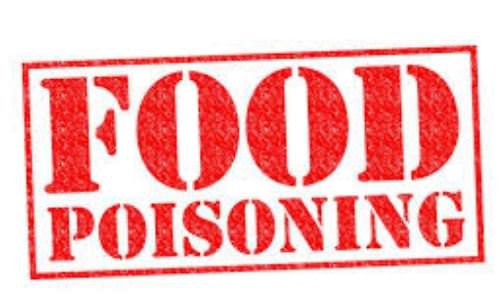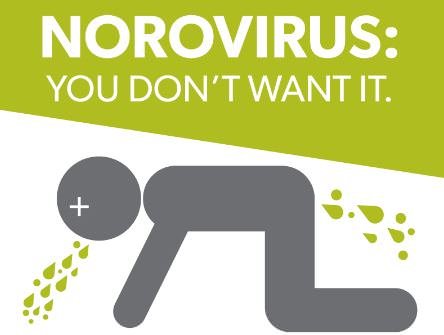How Do You Know If You Have Food Poisoning?
Most of us have experienced food poisoning...You know it’s like the vomiting and the diarrhea. The gastrointestinal torment that can leave you huddled miserably on the bathroom floor. But food poisoning, or food borne illness, isn’t just one thing. In fact, the U.S. Centers for Disease Control names 31 unique species of bacteria, viruses, and parasites as common culprits, but there are hundreds in total. And different microbes tend to contaminate different foods, cause slightly different symptoms, and have different incubation periods: the time between when you get infected and when you start feeling bad.

So figuring out if you have food poisoning and where you got it can be trickier than you might think. The number one cause of food poisoning in the U.S. is norovirus, which causes around half the cases, according to the CDC. Viruses are minimalist microbes. They’re basically some genetic material with a protein coat. So they can’t reproduce or do much on their own at all, they need a host cell. And when you eat a norovirus-contaminated salad, it finds plenty of hosts in your gut. When the virus finds an intestinal cell, it tricks membrane receptors to get inside, and then hijacks the cell’s machinery to make copies of itself. Eventually, those virus minions burst from the infected cell to find more victims. And at the same time, your dead and damaged cells release chemicals that trigger an inflammatory response in your body.

Nearby blood vessels dilate and leak plasma into the infected tissues, which kicks off the fight against the invaders. And more chemical signals are released to attract specialized immune cells. This inflammatory response in your gut contributes to some of the classic symptoms of food poisoning: diarrhea, vomiting, and sometimes a low fever. So just know that when you’re puking your guts out, at least that’s your own immune system kicking some microbe butt. It’s been difficult to study norovirus because, until recently, researchers haven’t been able to grow intestinal cell lines in the lab that it can infect and survive in. Before that, heroes among us have volunteered to be infected with norovirus so scientists could better understand it. Now, they’re even testing a norovirus vaccine in humans! But even though norovirus is the leading cause of food poisoning in the U.S., most cases of norovirus aren’t from food. It’s highly contagious, so infected people or contaminated surfaces can spread it too. And it’s commonly called a stomach bug or stomach flu, even though norovirus isn’t related to the influenza virus. So how do you know if you should blame your Uncle Carl’s fruit salad for your upset stomach? Well, that takes some detective work. The simplest way is to try finding the source: did any other people who ate the fruit get sick around the same time you did? Or did you start puking after hanging out with your buddy’s preschooler, who was a little under the weather? That’s basically how state health agencies and the CDC approach food poisoning outbreaks too, just on a bigger scale. They have to try trace the source, so they can stop the spread of a microbe. These agencies monitor reports of illness from hospitals to look for weird spikes or clusters of food borne illness. They’ll do DNA and RNA tests and perform other analyses on poop samples from patients to determine what microbe they’re dealing with, from norovirus, to bacterial baddies you may recognize like Listeria, E. coli, and Salmonella. Then, they’ll interview patients to generate and test hypotheses about where it came from. Like, if most of those patients ate the same brand of alfalfa sprouts, they’d go swab that produce packaging facility to look for the microbe. When they do find the source, they try to stop its spread. The state health agency may shut down a restaurant, or the Food and Drug Administration may recall a product. But, obviously, it’s kind of hard for you to do that level of investigation while you’re suffering by a toilet. It’s not like everyone can just run a molecular analysis for norovirus. The good news is, for most healthy folks who aren’t babies or old, food poisoning is a sucky illness, but you’ll get better on your own. So it’s not super important to know what kind of sick you are. The only way to really know what’s ailing you is to go to a medical professional. Which is also advisable if you don’t get better in a few days or if you get severely dehydrated from all that vomiting and diarrhea. So, like, if you’re worried, go to them. And you can be careful about what you eat to try and avoid food poisoning altogether. Pay attention to those recalls on local news, and wash your hands so you don’t spread any nasty microbes! And if you’re preparing fruits and veggies to eat raw, make sure you wash them. A thorough scrub is important even if you don’t plan to eat the outside, because, for instance, cutting into a melon can transfer microbes from the outer surface to that juicy middle. The FDA also recommends removing any bruised or damaged parts, and the outermost leaves of lettuce or cabbage. Plus, thoroughly cook your food, especially beef, poultry, and eggs. Because heat kills any bacteria that might be on them. So next time your friend or family member is taken down by food poisoning, you can share your fun facts with them...I’m sure they’ll be thrilled!
